When I show this photo to most people they respond with first glance certainty, “some kind of musical instrument?” Actually, this is cutlery drying in the rack. There’s not a dishwasher at my studio in Alaska and purposely, there are only enough forks and spoons for a couple of meals so washing dishes has become daily ritual.
Pull out the collapsible wash basin, fill with (thank the gods hot) soapy water, dawdle with the shine of the bubbles in the suds while accomplishing a task. A glance at the sun on these objects in the drying bin made a photo requisite. I was enraptured with the light and shadow reflecting in the sunlight.
So often we rush through our observations, often making a skewed assessment. Slow down. Look harder. Breathe. Look again. The facts are there, hiding out under what appears at first to be truth.






